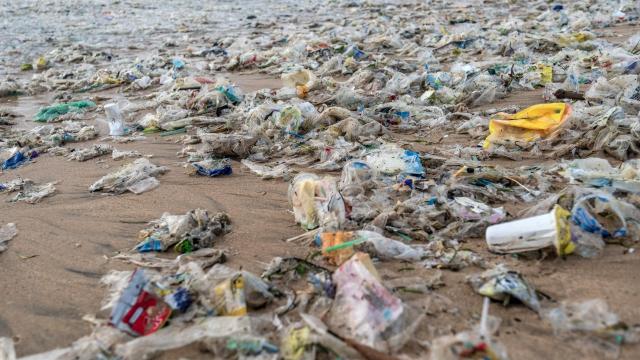Researchers looked at samples taken from oceans and soils around the world and found a vast number of enzymes that can degrade 10 different kinds of plastic.
The team believes that one in every four organisms in the microbiomes they surveyed carries a plastic-degrading protein sequence, which the team describes as an enzyme ‘homologue,’ meaning something that behaves like an enzyme but may not be identified as such. (Living organisms produce enzymes to digest foods.) The findings are a sign that some life is adapting to make use of the plastic pollution that has reached every corner of the globe.
“Currently, very little is known about these plastic-degrading enzymes, and we did not expect to find such a large number of enzymes across so many different microbes and environmental habitats,” study co-author Jan Zrimec, a biologist at Chalmers University in Sweden, said in a university press release. “This is a surprising discovery that really illustrates the scale of the issue.” The team’s research is published in mBio.
The issue is, of course, plastic pollution. Millions of tons of plastic enter the world’s oceans each year, according to the International Union for Conservation of Nature. Marine ecosystems contain shocking amounts of microplastics, and since plastics take a very, very long time to naturally decompose, it means that the world is becoming coated in our manufactured mess.
But some microbes seem to be evolving to take advantage of our pollution, the recent team found. Microbial species are metabolizing plastic in aquatic environments, landfills, and even plastic refineries, they reported.
“We found multiple lines of evidence supporting the fact that the global microbiome’s plastic-degrading potential correlates strongly with measurements of environmental plastic pollution — a significant demonstration of how the environment is responding to the pressures we are placing on it,” co-author Aleksej Zelezniak, also a biologist at Chalmers University, said in the same release.
The team looked at existing databases of environmental DNA samples from soils and ocean regions around the world, taken from three levels of the water column. Using computer modelling, they looked for protein sequences that would likely have the ability to break down plastic. They found there were more plastic-degrading enzyme homologues near highly polluted areas as well as deeper in the ocean, which corresponds to how microplastics are dispersed in the water column; the deeper you are, the more microplastics there are.
To minimise the number of false positives for plastic-degrading enzymes, the team also modelled the human microbiome, which has no known plastic-degrading enzymes. Enzyme hits similar to the ones in the human gut were treated as false positives.
Zelezniak suggested that if such plastic-degrading microbial communities could be investigated more thoroughly, their capabilities could be engineered to target specific kinds of plastic. Last year, another group of researchers found a strain of bacteria living in a trash dump that can break down the chemical bonds of polyurethane, a common and hard-to-recycle plastic.
Of course, we shouldn’t rely on microbes to address the problem we so actively perpetuate. Cutting down on plastic demand and production is probably a better course toward a cleaner Earth. Still, this research showcases just how remarkably adaptable life on Earth is, even in the face of environmental devastation.
